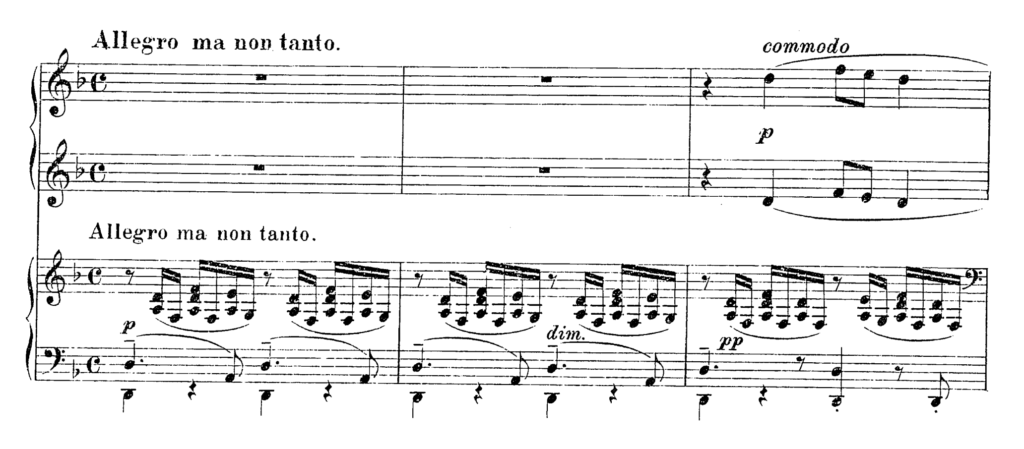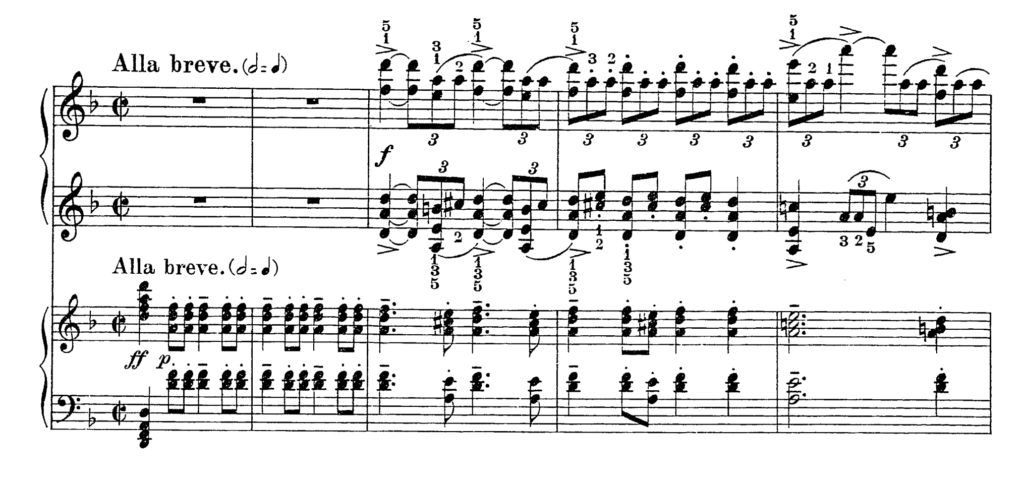Analysis
Contents
First Movement (Allegro ma non tanto)
Sonata-Allegro form
EXPOSITION
Bar 1: Intro.
Bar 3: Theme 1, played by the piano
Bar 27: Roles inverted. Piano plays the accompaniment, Violas and Horns play the melody.
Bar 52: Transition Part 1
Bar 69: Transition Part 2. A fragment of the 2nd subject played by the flutes, oboes, solo horn and trumpets.
Bar 77: Transition Part 3.
Bar 81: Transition Part 4. 1st Subject played by Bassoon and lower strings.
Bar 93: Theme 2A
Bar 107: Theme 2B
Bar 111: Counter theme, played by solo Bassoon.
Bar 124: Theme 2C
Bar 137: Transition
Bar 151: Closing Section. Cantabile version of Theme 2A, played by the Piano.
Bar 219: Closing Section Part 2. Counter melody played by the Clarinet.
DEVELOPMENT
Bar 167: Development Part 1
Bar 181: Development Part 2. Fragments of Theme 1 in Bassoons and Celli.
Bar 189: Sequence of Bar 181-188
Bar 199-202: Extension of sequence.
Bar 203: Development Part 3.
Bar 223: Development Part 4.
Bar 235: Development Part 5.
Bar 303: Cadenza Part 1
Bar 362: Cadenza Part 2.
Bar 363: Theme 1 played by the flute.
Bar 375: Cadenza Part 3. Theme 2A played by Piano.
RECAPITULATION
Bar 395: Intro.
Bar 387: Theme 1
Bar 421: Fragment of Theme 2A, played by Horns and Trumpets.
Second Movement (Adagio)
Hybrid form: ABACA, with theme and variations in A sections
A (Bar 1)
Bar 1-26: Theme
Bar 26: Transition
Bar 38: Variation 1
Bar 55: Variation 2
B (Bar 71)
Bar 71: Motif from theme, played by the Piano.
Bar 72: Extract of Theme 1 from Mvt. 1, played by the Violins.
A (Bar 85)
Bar 85: Variation 3
Bar 102: Variation 4
Bar 111: Variation 5
Bar 122: Transition
C (Bar 130)
Bar 130: Fast waltz
Bar 137: Reminiscence of Theme 1 from Mvt. 1, played by the Clarinets and Bassoons.
Bar 157: Violin 1 – Rhythm of Theme 2A from Mvt. 1.
Bar 184: Transition
A (Bar 190)
Third Movement (Alla breve)
Sonata-Allegro form
EXPOSITION
Bar 1: Intro
Bar 3: Theme 1A
Bar 39: Theme 1B
Bar 72: Theme 2A
Bar 103: Theme 2B
Bar 124: Closing Section
Bar 128: Theme 1A, leading to a close.
DEVELOPMENT
Bar 132: Development Part 1
Bar 152: Development Part 2
Bar 171: Development Part 3
Bar 178: Development Part 4
Bar 188: Development Part 5
Bar 194: Development Part 6
Bar 201: Development Part 7
Bar 202: Extract of Theme 1 from Mvt. 1, played by the Violas and Celli.
Bar 210: Development Part 8. Extract from Theme 2A, Mvt. 1.
Bar 223: Development, Part 9.
Bar 233: Development, Part 10.
RECAPITULATION (Bar 244)
Bar 248: Theme 1A
Bar 293: Theme 1B
Bar 304: Transition
Bar 320: Theme 2A
Bar 351: Theme 2B
CODA (Bar 382)
Bar 385: Coda Part 1A
Bar 406: Coda Part 1B
Bar 416: Coda Part 1C
Bar 439: Coda Part 2
Bar 507-508: Ending with Rachmaninoff’s signature rhythm. (Rach -Ma-Ni- Noff!)
Accompaniment
Orchestral Accompaniment of Rachmaninoff Piano Concerto No.3, tempo matched to Van Cliburn and Symphony of the Air, conducted by Kiril Kondrashin
Find out more: https://tonicchord.com/piano/90-rachmaninoff-piano-concerto-no3-in-d-minor-op30.html









